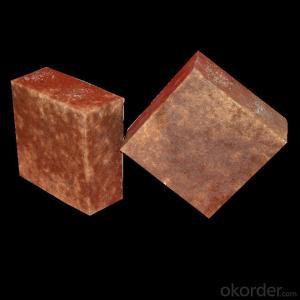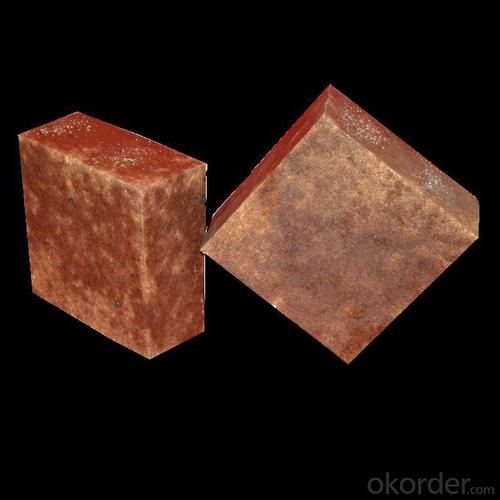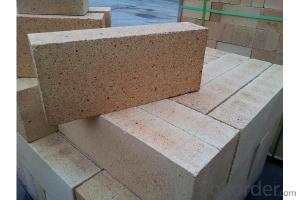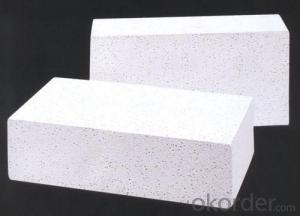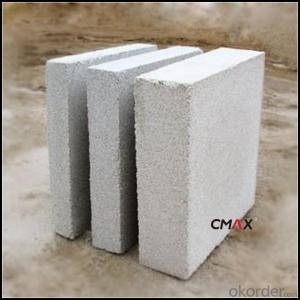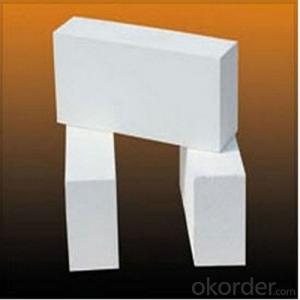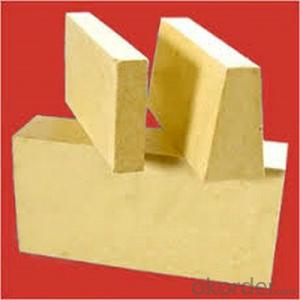Insulating Fire Brick for Ladle High Temperature Refractory Brick
- Loading Port:
- Shanghai
- Payment Terms:
- TT OR LC
- Min Order Qty:
- 10 m.t.
- Supply Capability:
- 100 m.t./month
OKorder Service Pledge
OKorder Financial Service
You Might Also Like
Quick Details
| Place of Origin: | (Mainland) | Shape: | Brick | Material: | Alumina Block |
| SiO2 Content (%): | 60-20% | Al2O3 Content (%): | 40-80% | MgO Content (%): | 0 |
| CaO Content (%): | 0 | Refractoriness (Degree): | 1770°< Refractoriness< 2000° | CrO Content (%): | 0 |
| SiC Content (%): | 0 | Model Number: | 69022000 | Brand Name: |
Packaging & Delivery
| Packaging Detail: | wooden pallet |
| Delivery Detail: | 30days |
Specifications
Refractory bricks for ladle, hot blast furnace
High alumina bricks
Fireclay bricks
Insulating bricks
Runner bricks
Our company located in yangquan city,Shanxi province, China, and Yanquan city is one of the
largest refractory material base in China. We are in position to supply various kinds of
refractory bricks, such as high alumina and fireclay bricks, insulating bricks etc
with the catalogue as follows:
1. fireclay brick
2. high alumina brick
3. insulating brick
4. unsintered phosphate brick
5. Al-C sliding plate
6. nozzle
7. hollowwares
8. refractory Mortar
9. refractory castables
10.other refractory material
If interested, pls do feel free to contact me.
Production can be arranged according to your specific requirements & drawings.
Looking forward to hearing from you the soonest.
FIRECLAY BRICK FOR GENERAL USE
Y-FB GFB40 GFB42 GFB45 |
Al2O3(%)min. 40 40 42 45 |
Fe2O3(%)max. 2.5 |
Refractoriness()min. 1710 1730 1750 1750 |
Refractoriness under load 0.2MPa()min. 1300 1350 1400 1400 |
Apparent porosity(%)max. 22 20 20 20 |
Cold crushing strength (MPa)min. 30 30 35 40 |
Linear change after reheating(%)max. At 1350×2h +0.1 -0.4 At 1400×3h +0.1 +0.1 +0.2 -0.5 -0.4 -0.2 |
Refractory Bricks
item | SK-32 | SK-34 | SK-36 | SK-37 | SK-38 |
Al2O3(%) | 38 | 42 | 50 | 65 | 70 |
Fe2O3 (%) | 3 | 2.5 | 2.5 | 2.4 | 2 |
Refractoriness (SK) | 32 (1710°C) | 34 (1750°C) | 36 (1790°C) | 37 (1825°C) | 38 (1850°C) |
Refractoriness under load, 0.2MPa, Ta, (°C) | 1300 | 1350 | 1450 | 1550 | 1580 |
Porosity (%) | 26 | 25 | 24 | 23 | 23 |
Bulk density (g/cm³) | 2.05 | 2.1-2.15 | 2.3-2.4 | 2.4 | 2.5 |
Cold crushing strength (MPa) | 25 | 25 | 45 | 45 | 51 |
- Q: Do insulating fire bricks require preheating before use?
- Yes, insulating fire bricks typically require preheating before use. Preheating the bricks helps to remove any moisture or volatile organic compounds that may be present in the material. This is important because moisture or volatile compounds can cause the bricks to crack or even explode when exposed to high temperatures. Preheating also helps to condition the bricks and prevent thermal shock, which can occur when the bricks are rapidly exposed to extreme temperatures. By slowly and gradually increasing the temperature, the bricks are able to expand and contract without any damage. Therefore, it is recommended to preheat insulating fire bricks before using them in order to ensure their durability and performance.
- Q: Do insulating fire bricks have a high fireproof rating?
- Indeed, insulating fire bricks possess a remarkable fireproof rating. These bricks have been specifically engineered to endure exceedingly high temperatures and offer exceptional insulation against the transfer of heat. They are crafted using specialized refractory materials with limited thermal conductivity, thereby aiding in the retention of heat and preventing its escape from the system. Insulating fire bricks are capable of withstanding temperatures ranging from 2300°F to 3100°F (1260°C to 1700°C), rendering them ideal for utilization in furnaces, kilns, fireplaces, and other applications involving elevated temperatures. Their elevated fireproof rating guarantees their ability to effectively safeguard structures and equipment from the intense heat and flames, enabling secure and efficient operations across diverse industries.
- Q: Can insulating fire bricks be used for insulation in power boiler walls?
- Yes, insulating fire bricks can be used for insulation in power boiler walls. Insulating fire bricks are designed to provide excellent thermal insulation, high temperature resistance, and low thermal conductivity. These properties make them suitable for use in power boiler walls, where insulation is crucial to reduce heat loss and improve energy efficiency.
- Q: Can insulating fire bricks be used for pizza ovens?
- Yes, insulating fire bricks can be used for pizza ovens. Insulating fire bricks are designed to withstand high temperatures, making them a suitable choice for creating a well-insulated and efficient pizza oven. They help retain heat, allowing the oven to reach and maintain the desired temperature for baking delicious pizzas.
- Q: Are insulating fire bricks resistant to vibration or seismic activity?
- Insulating fire bricks are generally not resistant to vibration or seismic activity. These bricks are designed to provide insulation and are therefore lightweight and porous. While they may be able to withstand minor vibrations or low levels of seismic activity, they are not specifically engineered to handle significant levels of shaking or tremors. In applications where vibration or seismic activity is a concern, it is advisable to use specially designed bricks or materials that are specifically manufactured to withstand these types of forces.
- Q: Can insulating fire bricks be cut or shaped using common tools?
- Indeed, common tools can be utilized to cut or mold insulating fire bricks. These bricks are typically composed of lightweight refractory substances like clay and minerals, making them more amenable to cutting and shaping than conventional fire bricks. To achieve the desired dimensions and design, one can employ basic tools such as a handsaw, angle grinder, or even a chisel and hammer. However, it is crucial to prioritize safety when handling insulating fire bricks by donning protective gear like gloves, goggles, and a dust mask. This precautionary measure is necessary to avert any potential health risks.
- Q: Can insulating fire bricks be used in the construction of heat recovery systems?
- Yes, insulating fire bricks can be used in the construction of heat recovery systems. Insulating fire bricks are designed to withstand high temperatures and provide excellent thermal insulation, making them an ideal choice for heat recovery systems. These bricks are made from lightweight materials, such as ceramic fibers or refractory materials, which have low thermal conductivity. This property allows them to effectively trap and retain heat, preventing it from escaping the system and maximizing energy efficiency. Additionally, insulating fire bricks are resistant to thermal shock, meaning they can withstand rapid temperature changes without cracking or breaking. This makes them suitable for the varying heat conditions often found in heat recovery systems. Overall, using insulating fire bricks in the construction of heat recovery systems can help improve their performance and efficiency by minimizing heat loss and optimizing energy recovery.
- Q: Can insulating fire bricks be used for insulation in hot water tanks?
- Yes, insulating fire bricks can be used for insulation in hot water tanks. Insulating fire bricks are designed to have excellent thermal insulation properties, making them an ideal choice for insulating hot water tanks. These bricks can effectively prevent heat loss from the hot water tank, helping to maintain the temperature of the water for longer periods of time. Additionally, insulating fire bricks are highly durable and can withstand high temperatures without cracking or breaking, making them a reliable choice for hot water tank insulation.
- Q: Is it possible to recycle used insulating fire bricks?
- Yes, it is possible to recycle used insulating fire bricks. Insulating fire bricks are made from various materials, such as alumina, silica, and other refractory materials. These materials can be broken down and reused in the production of new bricks or other refractory products. Recycling used insulating fire bricks can help reduce the demand for new raw materials and minimize waste. However, it is important to note that not all recycling centers or facilities may accept insulating fire bricks, so it is advisable to check with local recycling programs or specialized recycling companies that deal with refractory materials.
- Q: What is the typical moisture content of an insulating fire brick?
- The moisture content of an insulating fire brick can vary depending on factors such as its specific composition, the manufacturing process used, and the conditions in which it is stored. However, insulating fire bricks are typically designed to have minimal moisture content in order to enhance their insulation capabilities and resistance to thermal shock. Generally, insulating fire bricks have a moisture content ranging from 0.5% to 2%. This low moisture content is crucial in preventing the bricks from cracking or spalling when exposed to high temperatures. Additionally, it reduces the risk of damage caused by moisture, such as freeze-thaw cycles or the release of steam upon heating. To ensure the optimal performance and longevity of insulating fire bricks, it is advisable to store them in a dry environment and protect them from moisture during transportation and installation.
Send your message to us
Insulating Fire Brick for Ladle High Temperature Refractory Brick
- Loading Port:
- Shanghai
- Payment Terms:
- TT OR LC
- Min Order Qty:
- 10 m.t.
- Supply Capability:
- 100 m.t./month
OKorder Service Pledge
OKorder Financial Service
Similar products
Hot products
Hot Searches
Related keywords
